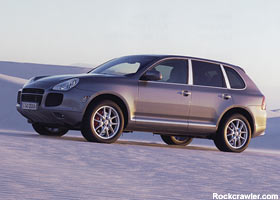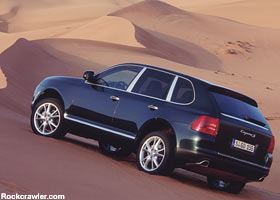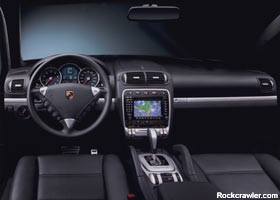The map-controlled longitudinal differential lock and the rear axle differential, available as an option, not only respond to any lack of traction on the front or rear wheels, but also incorporate sensors measuring vehicle speed, lateral acceleration, the steering angle, and gas pedal operation. PTM calculates the optimum locking action on both axles and spreads out drive forces as needed to the front and rear wheels. Therefore, PTM might be compared with a forward-looking, anticipative active electronic control system providing exactly the right balance for superior driving stability and supreme safety when changing lanes both at high speeds or when driving at a moderate pace on ice and snow. Some of the particular benefits PTM provides are:
Porsche Stability Management (PSM), also standard on Cayenne, maintains a constant dialogue with PTM but only intervenes when the vehicle reaches its physical limit. Coordinating essential systems such as the anti-lock brake system (ABS), the automatic slip regulation (ASR), and the automatic brake differential (ABD), PSM is immediately available whenever the Cayenne enters critical over- or understeer conditions, "telling" PTM to open the differential locks in order to re-stabilize the car by applying the brakes specifically on individual wheels. Sporting
and agile on the road; robust when driving off the beaten track Made of high-strength steel, the subframe design has an arch-shaped crossbar and inclined ramps at the front that give the Cayenne ample ground clearance of up to 273 mm, or 10.75 inches. The steering transmission with its variable transmission ratio and the differential are both well protected on top of the subframe to help guarantee robust off-pavement driving qualities. The rear axle is another new Porsche development. The rear axle configuration is an elaborate multi-arm concept easily able to handle both high traction forces and the Cayenne's high service load capabilities. In the interest of extra comfort and noise reduction, the rear axle is also mounted on a subframe resting on extra-large, hydraulically dampened rubber bearings. Again, the subframe is made of high-strength steel for optimal weight and maximum structure stiffness. The lower track control arm and the tie-rod are both made of steel plate to ensure robust strength even on the roughest surfaces. The upper track control arm assembly, which is well protected within the vehicle, is made of extra-light forged aluminum components. Through its particular configuration, the axle kinematics reduces undesired squat and dive when accelerating and braking, keeping the Cayenne almost entirely level on the road at all times. The rear axle configuration and the rear toe-in control stabilize the vehicle's driving behavior particularly in bends and under load change. A special feature of the axle concept is the extra-long spring travel for off-pavement purposes. The pneumatic spring suspension, standard on the Cayenne Turbo, comes with inward and outward spring travel of 102 and 118 mm (4.02 and 4.65 inches), respectively, on the front axle, and 124 and 125 mm (4.88 and 4.92 inches) at the rear. Inward and outward spring travel on the steel spring suspension of the Cayenne S is 104 and 116 mm (4.09 and 4.57 inches), respectively, at the front and 135 and 98 mm (5.31 and 3.86 inches) at the rear. As an option, the Cayenne S is also available with pneumatic, air-controlled spring suspension.
Incorporating six different ride height levels, the pneumatic suspension adjusts over a range of 116 mm (4.57 inches).
Active
damper control PASM also gives the Cayenne driver the opportunity to choose among three damper settings while driving - Comfort, Normal or Sports. Consistently operating in the background, PASM always maintains its active control function, comparing the operator's driving style with the program currently in use. Whenever the driver has chosen a particularly comfortable damper setting but is driving in a more sporting or dynamic style, the system automatically switches over to the sports mode and makes the dampers firmer. A real
champion on rough terrain The Cayenne's standard off-pavement driving characteristics can be enhanced to a higher level. In the event individual wheels lose contact in demanding terrain, a direct and rigid connection of the four-wheel drive system provides mobility. Operating the off-pavement switch a second time activates the 100 percent front-to-rear differential lock, and the Cayenne Turbo's standard pneumatic suspension provides additional assistance when climbing. In the special off-pavement mode, which provides 273 mm or 10.75 inches ride height, the inclination angle is up to 32 degrees at the front and 27 degrees at the rear, enabling the Cayenne to handle steep ramps. Even extreme crests when driving from one gradient to another are not obstacles since the 25-degree ramp angle prevents the body between the axles from touching the ground prematurely. Both models are equipped for water crossing up to a half meter deep (556 mm or 22 inches when set to the special off-pavement level) thanks to the Cayenne's special sealing concept, a high-rise intake funnel, its elevated transmission purge opening, and full encapsulation of the side sills.
The package also uses anti-roll bars on the front and rear axle, which are hydraulically activated and deactivated by a switch in the center console. This increases front and rear axle lock by 70 mm or 2.76 inches, which improves ride comfort by minimizing body sway and enhancing off-pavement driving qualities and traction when negotiating rocks, tree trunks or bumps. To ensure the Cayenne's sporting driving qualities on the road, the anti-roll bars can only be disconnected in the low range mode. As soon as the Cayenne, with its anti-roll bars disconnected, returns from rough terrain to the road, the anti-roll bars are automatically reconnected once the vehicle exceeds 50 km/h or 31 mph to provide the additional stability required for on-pavement driving as a safety feature. Featuring an all-new, Porsche designed and manufactured 340 bhp (DIN) V8 engine, the Cayenne S accelerates from 0 to 100 km/h (0 to 62 mph) in 7.2 seconds and reaches a top speed of 242 km/h or 150 mph. The Cayenne Turbo also features a 4.5-liter V8 engine, but develops a maximum of 450 bhp (DIN) thanks to two exhaust gas turbochargers complete with intercoolers. This ensures acceleration from 0 to 100 km/h (0 to 62 mph) in 5.6 seconds with a top speed of 266 km/h or 165 mph. Cayenne production will take place in Leipzig, Germany, in a newly constructed manufacturing facility, but its engine - or heart - will be built in Zuffenhausen. Porsche will produce approximately 25,000 Cayenne SUVs during the first full year of production, 70 percent of which will be for export worldwide, including the United States and Canada. In anticipation of the Cayenne's arrival, Porsche Cars North America (PCNA) recently launched the Cayenne Crossing Initiative, a multi-year program designed to reclaim America's paved and unpaved roads. Chaired by actor James Brolin, the program will include a variety of U.S. road restoration and maintenance projects along a route that stretches from coast to coast. Cayenne Crossing Initiative partners will include Treadlightly!, the Illinois Department of Transportation, the San Bernardino National Forest Association and the Porsche Club of America. Initial restoration efforts will begin this summer in California's San Bernardino National Forest and Virginia's George Washington National Forest. For more information about the Cayenne, visit www.porschecayenne.com. For more information about the Cayenne Crossing or to download Cayenne images, visit www.press.porsche.com. Cayenne images will also be available from PR Newswire. PCNA, based in Atlanta, Ga., and its subsidiary, Porsche Cars Canada, Ltd., are the exclusive importers of Porsche vehicles for the United States and Canada. A wholly owned, indirect subsidiary of Dr. Ing. h.c.F. Porsche AG, PCNA employs approximately 200 people who provide Porsche vehicles, parts, marketing and training for its 204 dealers in North America. They, in turn, provide Porsche owners with best-in-class service. Cayenne S and Cayenne Turbo Specifications
* Variable ground clearance figures are the result of the pneumatic air-controlled spring suspension that is standard on the Cayenne Turbo. Pneumatic suspension is offered as an option on the Cayenne S.
|
|||||||||||||||||||||||||||||||||||||||||||||||||||||||||||||||||||||||||||||||||||||||||||||||||||||||||||
|
|
|




